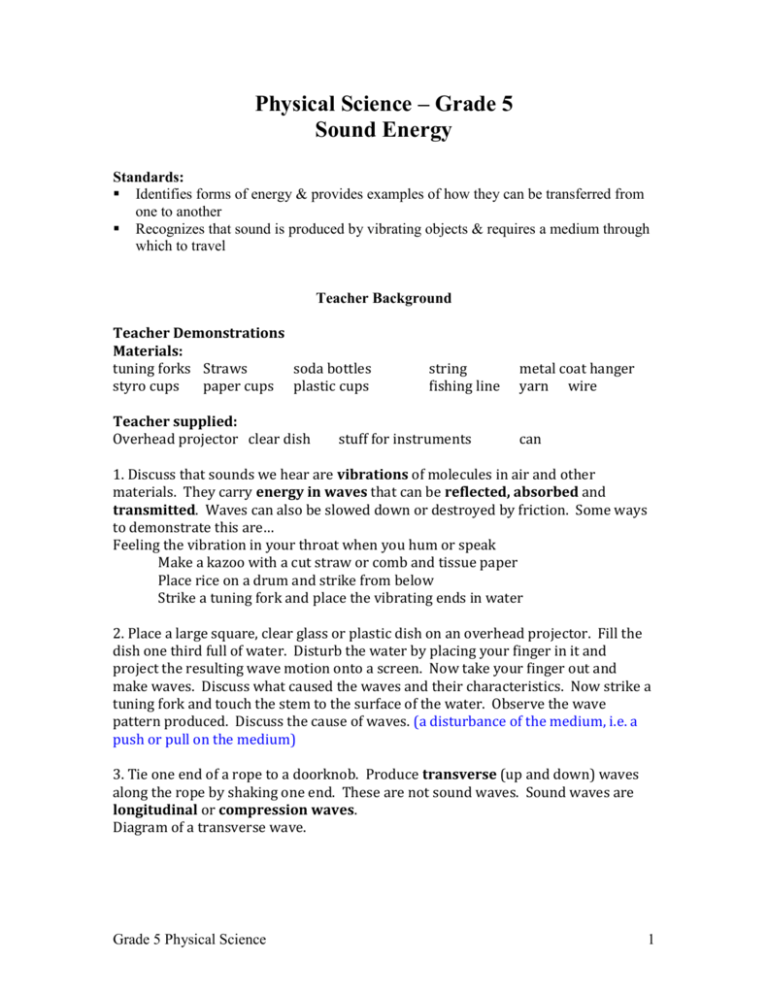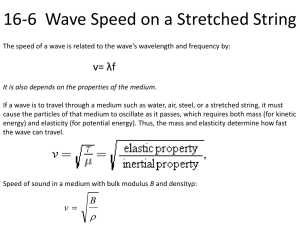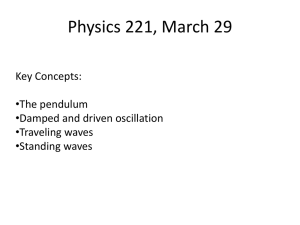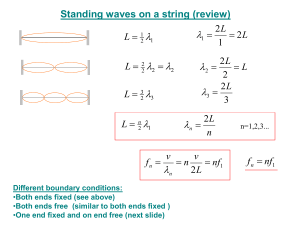wave experiments
advertisement

Physical Science – Grade 5 Sound Energy Standards: Identifies forms of energy & provides examples of how they can be transferred from one to another Recognizes that sound is produced by vibrating objects & requires a medium through which to travel Teacher Background Teacher Demonstrations Materials: tuning forks Straws soda bottles styro cups paper cups plastic cups Teacher supplied: Overhead projector clear dish string fishing line stuff for instruments metal coat hanger yarn wire can 1. Discuss that sounds we hear are vibrations of molecules in air and other materials. They carry energy in waves that can be reflected, absorbed and transmitted. Waves can also be slowed down or destroyed by friction. Some ways to demonstrate this are… Feeling the vibration in your throat when you hum or speak Make a kazoo with a cut straw or comb and tissue paper Place rice on a drum and strike from below Strike a tuning fork and place the vibrating ends in water 2. Place a large square, clear glass or plastic dish on an overhead projector. Fill the dish one third full of water. Disturb the water by placing your finger in it and project the resulting wave motion onto a screen. Now take your finger out and make waves. Discuss what caused the waves and their characteristics. Now strike a tuning fork and touch the stem to the surface of the water. Observe the wave pattern produced. Discuss the cause of waves. (a disturbance of the medium, i.e. a push or pull on the medium) 3. Tie one end of a rope to a doorknob. Produce transverse (up and down) waves along the rope by shaking one end. These are not sound waves. Sound waves are longitudinal or compression waves. Diagram of a transverse wave. Grade 5 Physical Science 1 4. Form a human wave by having ten people stand in a line, largest to smallest, with arms locked together, and push the last person into the length of the line.(longitudinal or compression wave) 5. Invite the music teacher to work with you to teach sound or invite him/her into your class with instruments to explain how sound is produced by them. (Emphasize the vibration of the instrument and the air so the sound energy gets to your ear) Diagram of a sound wave (compression or longitudinal) You can also make a transverse wave by pulling the last person forward, perpendicular to the line. (transverse wave) Grade 5 Physical Science 2 6 Point out that both kinds of waves have a wavelength that can be measured from crest to crest, trough to trough, or any other two corresponding points. (Use this diagram http://www.glenbrook.k12.il.us/GBSSCI/PHYS/CLASS/sound/u11l1c.html 7. Have students diagram a compression wave and a transverse wave. Label its wavelength, direction of travel, crest (compression), trough (rarefaction) and amplitude. 8. Demonstrate that sound is related to mechanical vibration by tightly covering a pot with aluminum foil or plastic wrap. Sprinkle some salt on the cover. Tap the side of the pot, yell, bring a speaker close, or clap and the salt will dance around as the sound causes it to vibrate. Relate sound to mechanical vibrations of all sorts. For example, a drum beat, the snap of a breaking stick, a truck rumbling by on a street. Discuss the vibration one can feel in the speaker of a stereo. 9. As an aside, kids may be interested to know that AM is Amplitude modulation and FM is frequency modulation for radio waves. Radio’s are receivers and you can explain the scientific meaning of "tuning in" a certain radio station (matching the radio receiver amplitude, AM or frequency, FM to the sending radio station wave). 10. Use student-made instruments to illustrate volume and pitch (one-string guitar, sandpaper blocks, paper tube kazoo, wind chimes, wood block tambourine, tongue depressor finger piano, garden hose recorder, etc.) Have students explain how they produce a vibration (use the term vibration instead of sound) 11. Explain that in space, sound cannot travel because there is no medium (air) to carry the sound wave vibrations. Types of sound variations Teacher background/Demonstrations (these can also be used as exploration stations) Volume is a change in the amplitude of the sound wave Pitch is a change in the frequency of the sound wave. (smaller, more frequent waves have a high pitch, longer, less frequent have a low pitch) Think instrument size and the column of air that can vibrate (flute compared to tuba, bass guitar string compared to lead) Grade 5 Physical Science 3 Lesson 1 - Pitch (These are demonstrations of producing vibrating air and changing the pitch by changing the size of the wave. Change the size of the air or string vibrating and the pitch changes. These can be set up as learning stations or classroom demonstrations.) Materials: straws Bottles String instruments Wind instruments Tuning forks Procedure: 1. Each student can experiment with a pitch by blowing across the open end of a straw. Pinch the other end. Produce a sound. Now pinch at a different spot. (a shorter air column) and produce a sound. Continue to change the size of the air column, which changes the frequency of the waves, i.e. pitch. (a shorter air column produces a shorter sound wave or vibration thus a higher pitch) 2. Use bottles partially filled with water. Tap them if glass, blow across the tops if they are plastic 3. Strings on an instrument. Make the string longer or shorter by pressing it against the fret. This is a great chance for a student who plays an instrument to demonstrate. 4. Wind instrument. (recorder, flute, clarinet etc) The keys make the air column longer or shorter and change the pitch (length of the wave and thus frequency of the waves) 5. Compare size of tuning forks. Have student practice matching the pitch of the fork with their voice by singing. Have them note the changes they need to make with their vocal cords to match the note. (tighten to raise pitch, lengthen to lower pitch) Grade 5 Physical Science 4 Lesson 2 - Sound and media Demonstrate that sound waves change depending upon the medium (stuff) it travels through. 1. Tap on a desk with your head on the desk and without your head on the desk 2. Record student voices on the computer. Listen to a recording of your own voice. You hear your voice through your bones, everyone else hears you through the air. The way you sound on a recording is how everyone else hears you. 3. Tie a string to a metal coat hanger. Tap the coat hanger with something metal and listen to the sound. Press the string next to your ear and tap the hanger with metal. It will sound like a church bell. Video summary of sound terms: This is an excellent short video. http://videos.howstuffworks.com/discovery/27960-assignment-discovery-scienceof-sound-video.htm Vocabulary List Sound Wave Frequency Grade 5 Physical Science Pitch Vibration medium amplitude transverse wave longitudinal wave 5 Student experiments Can You Hear Me Now? String Telephones Teacher info http://www.teachengineering.org/view_activity.php?url=http://www.teachenginee ring.org/collection/cub_/activities/cub_sound/cub_sound_lesson02_activity1.xml Use the above link to make string telephones. Materials: styro cups Fishing line paper cups yarn plastic cups wire cotton string paper clips Procedure: 1. Build a string telephone with 8 feet of cotton string and paper cups. 2. Have students replace one item (either cups or string) and determine if the phone works better or worse at a certain distance. (The students will have to determine a way to test if it works better. This is part of the purpose of the lab, to learn about experiment design) 3. Record the data in the table like the one below. The string telephone teaches how sound travels differently through different materials. (called the medium) Try cotton string, fishing line, wire, yarn and see which works better. Also try different cups, paper, plastic, Styrofoam. Questions 1. How did you measure if the phone worked better? 2. What materials worked best to conduct sound energy? Which materials were poor at conducting sound? 3. Why do you think some materials are unable to carry the sound waves well? 4. Name one thing that would improve your telephone? Include sound wave vocabulary in your answer Grade 5 Physical Science 6 How Does a String Phone Transmit Sound? Students will explore how well sound energy (vibrations) travels through the string medium Materials: cup, string Procedure: 1. 2. 3. 4. 5. 6. Make a phone with 6 feet of string. Record how the phone works when you use it across the room Hang a paper clip on the string, have someone speak. Try using the phone around a corner. Record the results below. Try using the phone with the string loose. Record the results below. Try using the phone with two strings and 4 cups. Record the results. Questions: 1. Explain how the sound energy gets from one cup to another with two cups and one string. Hint: Watch the paper clip on the string while someone speaks into the cup, you can see better what is happening. 2. How did the phone work with the string tight? Why? (What happened to the sound energy?) 3. How did the phone work around the corner? Why? (What happened to the sound energy?) 4. How did the phone work with a loose string? Why? (What happened to the sound energy?) Grade 5 Physical Science 7 Phone network Students will explore how to allow 3 people to speak and listen on the same string telephone, i.e. build a phone network. Materials: cup, string, paper clips Procedure: 1. Have a team of three or four students design a phone that will allow all of them to listen to each other. Draw what it will look like on the back. 2. Have the students build the phone network and test it 3. Write an explanation of how the sound energy gets to all the phones. Questions: 1. Draw the phone network in your journal or on a piece of paper. 2. Explain how the network allows everyone to hear by labeling the diagram and writing an explanation below the picture. Use the terms vibration, medium and energy. Grade 5 Physical Science 8 Wireless Phones (Cell or Regular Wireless) Materials: cell phones Procedure: 1. Have students examine some cell phones. 2. Determine the energy source of the phone. (battery) 3. In terms of energy transformation, what happens when you speak into the phone?(sound to electrical to electro-magnetic waves (radio) to electrical to sound on the other phone) (an older cell phone with an antenna may help them to understand how the phone works like a radio) 4. Ask students to explain how their mom can hear them if they call home. (cell phone sends signal to tower- tower sends signal to moms cell phone) 5. Can another person intercept your cell phone signal? (Hint: the cell phone works like a radio. Can another radio intercept a stations signal?) Extensions Design a sound catcher (similar to the outer ear)(think 1800’s hearing device) Try to make a tuning fork begin to vibrate by playing the same note on an instrument near it (this is called resonance) Explore the vibrating properties of recycled objects. (recycled percussion) Play with the sound recording feature on a computer (note graph) Download sound mixer software http://audacity.sourceforge.net/download/windows http://www.colby.edu/cpse/equipment2/chem/tuning.html Bell’s telephone experiment – converting sound vibrations to electrical vibrations and back again to sound. http://atcaonline.com/phone/sciencefork.html Grade 5 Physical Science 9 Physical Science – Grade 5 Light Energy Standards: Identifies forms of energy & provides examples of how they can be transferred from one to another Recognizes that light can be reflected, refracted, and absorbed Teacher Background 1. Visible light is a transverse wave (See diagrams in sound kit) that is a form of the electromagnetic spectrum or EM. EM waves includes visible light, infrared, ultraviolet, radio/television waves, and microwaves. 2. Light waves can be understood partially by considering visible waves in water. They can be reflected and absorbed. 3. Reflection is the bouncing of a wave off of an object, sending it in a different direction. 4. Refraction is the bending of light waves by slightly slowing or speeding up the wave. This is done by sending the light through different media. For example, light traveling through air, then water or light traveling through air then glass. Also, curved surfaces can bend the light waves. These are called lenses. 5. Absorption is when light energy is collected by an object. The light seems to disappear, but the energy has been converted by the object from light to something else, usually heat. Grade 5 Physical Science 10 Experiment 1 - Reflection Relay Objective: To learn the law of reflection Materials Needed: Darkened room Different targets 3 (or more) pocket sized mirrors for each group one overhead projector or bright flashlight (no lasers) Rules: 1. The light must strike each of the three (or two if the light is dim) mirrors before hitting the target (there may be obstacles that the beam of light will have to be directed around). 2. The team members must use all three mirrors to change the light's path. 3. Each team must hit a different target. Procedure: 1. Explain the game. 2. Choose a starting point for all teams. Each team will then get a different target to hit with their light. 3. Each team will be able to have a “lifeline” to help them. (Another student they can call on for help) Questions: 1. On the back, draw a picture of the room. Make the light beam in yellow and show how you got the light to the target. Label each team member with a mirror. 2. If the light came from your left and hit a mirror, in which direction would it bounce? Draw a diagram of this. Left Right Mirror 3. Complete the reflection diagram. Grade 5 Physical Science 11 Reflection Set up Mirror X Draw a line from A, B and C to the X to show where the light will go. A Blue crayon B Red crayon C Green crayon Grade 5 Physical Science 12 Experiment 2 – Funny Reflections Materials Unframed rectangle mirror notecards Procedure – 1. Write three of the following words in large even capital letters on a notecard (CHEEK, BIKE, DECIDE, BOX, CHICK, CHOKE, BOOK) or use attached list 2. Cut each word in half. 3. Place mirror vertically against the paper. (so you can see the word in the mirror) Questions – 1. Will this work with all printed words? 2. Which letters, when cut in half will appear whole? 3. Write your name and try the mirror trick. Does it work with your name? Teacher Info Strategy – The words are symmetrical. All mirror images are left/right reversed. The image in the mirror also shows that all images are actually found behind the mirror. (Thus the Alice through the Looking Glass, it seems as if another world exist behind the mirror) Grade 5 Physical Science 13 CHEEK= =BIKE= =DECIDE= =BOX= =CHOKE= =BOOK= Grade 5 Physical Science 14 Experiment 3 Materials: mirror star sheet notecard to block vision Procedure: http://www1.curriculum.edu.au/sciencepd/teacher/assessment/light/refl_refl.htm Star sheet and data sheet in Light Folder Experiment 4 - Look at Yourself as Others See You (could also be done as a demonstration) Materials - Two rectangular mirrors without frames Procedure 1. Have one student stand the two mirrors perpendicular (90 degrees) to each other. 2. Have one student look into the mirrors with their hands on the desk so they are visible in the mirrors. 3. While the student continues to look, have another student slowly begin to move the mirrors to a 180 degree angle. Make Observations. Questions – 1. Why did the left hand appear on the right in the perpendicular mirror? 2. How do light rays travel from the object to mirror and back to the observer's eye? 3. What happened to your image when the mirrors were straightened? Conclusion - The light ray of the object (which is yourself) are reflected in 90 degree angles from one mirror to the other and then back to the eye. In a regular straight mirror, the rays bounce right back to the eye without being reversed. Grade 5 Physical Science 15 Experiment 5 – Reflection Games Material Pong Video Game and computer Procedure - Play the game Questions - Who won? Why? Strategy - Just as the tennis ball is reflected off a wall-a narrow beam of light is reflected from a mirror (the angle of incident is equal to the angle of reflection.) http://www.falstad.com/pong/ http://www.xnet.se/javaTest/jPong/jPong.html Experiment 6 - Refraction Do demonstrations 1, 2, 3, 5, 6 and 8 http://www1.curriculum.edu.au/sciencepd/teacher/assessment/light/refr_what.htm Grade 5 Physical Science 16 Experiment 7 - Can a Lens Form an Image on a Screen? Materials: convex lens magnifying lens a piece of white cardboard to form a screen. Procedure: 1. Hold a convex lens up to the window and place a white cardboard screen behind the lens. 2. Move the card towards or away from the lens, until an image of the screen outside the window is focused on the screen. 3. Record the appearance of the image on the screen. 4. Investigate what happens if lenses of different thickness are used to form the image on the screen. Describing images To describe an image you should observe: 1. 2. 3. 4. 5. whether it is upright or upside down whether it is larger or smaller than the object whether it is coloured or black and white the distance between the lens and the screen any other difference. Discussion 1. Describe the image on your screen. 2. What optical devices can you think of that use lenses to form an image on a screen? Grade 5 Physical Science 17 Physical Science - Grade 5 Forms of Energy/Energy Transformation Standards: Identifies forms of energy & provides examples of how they can be transferred from one to another Teacher Background 1. Energy is the ability to do work (create a change in motion or position). It is a poor definition, but energy is a rather mysterious concept. 2. Energy comes in many different forms. Heat, light, sound, electro-magnetic, mechanical (physical movement), nuclear, chemical 3. Energy transformation- energy can be converted from one form to another. Energy is always lost in the transformation from one form to another to friction 4. According to the Grand Unified Theory (GUT), all energy is the same. There is really only one kind of energy only in different forms. Lesson 1 1. Have students identify different forms of energy from pictures or classroom examples or... 2. List the forms of energy on a board, have students record them and find examples in the room. Pencil sharpener (mechanical, electrical?, friction, sound) Computer (electrical, light, sound) Book (chemical energy in paper) Loudspeaker (electrical, sound) Cell phone (electrical, sound, light, mechanical(vibrate mode) Person (chemical energy, electrical, sound, mechanical and heat) Battery (chemical and electrical) Lesson 2 1. Have students identify the energy transformations in a string telephone or electrical circuit. Ask if the transformations can be done in reverse? For example, if electricity can be changed into mechanical energy can mechanical energy produce electricity? (this is a good research/homework type of question) 2. Show students an example of an item from around the room that has at least 3 different types of energy transformations. For example, an electric pencil sharpener turns electricity into mechanical energy (motion), sound and heat. 3. Have the students choose 5 different things in the room that show 3 different forms of energy. This concept can be returned to many times during the year, whenever science lessons are being done and are included in the other lessons in the kits. Grade 5 Physical Science 18






